 John Morris Changes His D-Day Tune
John Morris Changes His D-Day Tune
On November 11, 2014 John Morris sent out the following email to his own list:
Subject: TONIGHT on CNN
Hi Friends Everywhere
Yesterday I met with Christiane Ampanpour [sic] in the London studios of CNN. The result is a seven minute broadcast, pegged on Remembrance Day and Armistice Day, which will run on her regular program tonight Tuesday November 11 at 19:00 GMT, 20:00 Paris time, and will be available later by Internet.
Message courtesy of our hostess in London Irene Walsh.
Happy Listening,
John
PS Home tomorrow for the first night of Paris Photo. Robert Pledge and I are speaking at the Frontline Club here tonight, about our new book Quelque Part en France.
•
 Yes, that’s the same Robert Pledge who dismissed the research published here into Capa’s D-Day pictures during the q&a that followed his June 24 dialogue with Morris at the International Center of Photography, with the words “What does A. D. Coleman know? He wasn’t there!” The same Robert Pledge who has involved Contact Press Images, the picture agency he runs, in a large-scale business venture with Morris that includes a touring exhibition of the photographs Morris made during the four weeks in which he carried a camera through Normandy in the summer of 1944. Plus the above-mentioned book in multiple editions that serves as the catalogue for said show. Not to mention a limited-edition portfolio of the images, 20 sets of 20 prints each. Conservatively estimated, that represents a $150K financial involvement with the former LIFE picture editor. No wonder Pledge feels protective of that investment.
Yes, that’s the same Robert Pledge who dismissed the research published here into Capa’s D-Day pictures during the q&a that followed his June 24 dialogue with Morris at the International Center of Photography, with the words “What does A. D. Coleman know? He wasn’t there!” The same Robert Pledge who has involved Contact Press Images, the picture agency he runs, in a large-scale business venture with Morris that includes a touring exhibition of the photographs Morris made during the four weeks in which he carried a camera through Normandy in the summer of 1944. Plus the above-mentioned book in multiple editions that serves as the catalogue for said show. Not to mention a limited-edition portfolio of the images, 20 sets of 20 prints each. Conservatively estimated, that represents a $150K financial involvement with the former LIFE picture editor. No wonder Pledge feels protective of that investment.
 Pledge’s disparagement notwithstanding, it appears I must know something. Because Morris recently went to the not inconsiderable trouble of seeking out a sympathetic colleague with a respected international platform for his recantation of the story he’s peddled for 70 years. Christiane Amanpour served as the presenter who gave Morris his ICP Lifetime Achievement Award on May 10, 2010. I suspect Morris and his associates deliberately chose her — and her high-profile CNN show — for this moment, in which they’d use the pretext of Veterans Day to (a) revise his D-Day narrative and (b) plug his new book and exhibition.
Pledge’s disparagement notwithstanding, it appears I must know something. Because Morris recently went to the not inconsiderable trouble of seeking out a sympathetic colleague with a respected international platform for his recantation of the story he’s peddled for 70 years. Christiane Amanpour served as the presenter who gave Morris his ICP Lifetime Achievement Award on May 10, 2010. I suspect Morris and his associates deliberately chose her — and her high-profile CNN show — for this moment, in which they’d use the pretext of Veterans Day to (a) revise his D-Day narrative and (b) plug his new book and exhibition.
Amanpour considered it worth posting on her Facebook page: “Breaking Photo news! Capa’s ‘lost’ D-Day images may never have been shot at all. Listen to what his editor tells me.”
•
The Amanpour-Morris segment ran on November 11. You’ll find it here at the CNN website, embedded in the November 12 follow-up story by Madalena Araujo, “Robert Capa’s ‘lost’ D-Day photos may never have been shot at all, says his former editor.” It begins with Amanpour leading Morris through his standard account of those events, which he rattles off in his usual practiced fashion. Then comes the surprising, salient passage (at timestamp 3:00):
Amanpour: It still makes me sick to my stomach to think that that evidence may have been lost forever.
Morris: Well, it now seems that maybe there was nothing on the other three rolls to begin with. Experts recently have said you can’t melt the emulsion off films like that and he just never shot them. So I now believe that it’s quite possible that Bob just bundled all his 35 [35mm film] together and just shipped it off back to London, knowing that on one of those rolls there would be the pictures he actually shot that morning. So we may not have lost anything at all that he had shot. That remains to be seen.
Amanpour: That’s … that’s news!
Morris: That’s new.
So news, and so new and important that, instead of asking a follow-up question, Amanpour opts not to pursue it further, instead switching immediately to the pressing subject of … Morris’s new book and exhibition of his own photos! (In their relation to this story, Amanpour and Marie Brenner have given a whole new meaning to the term “investigative journalism.”)
Here Morris echoes what he said in the summer 2014 interview published recently by Black & White magazine:
“It looks now that the other images were never lost, they just never even happened. … The new theory is that there was never anything on those three rolls — that Capa had those four rolls with him and there was such intense action that when he jumped on the LST to go back to England, he just bundled the four rolls together and, to play safe when he got to Portsmouth, sent me the four as well as the medium-format film he had shot with his Rollei of the troops going over and of the wounded on the way home.”
I don’t know whose “new theory” Morris espouses here — certainly not mine, nor that of anyone who has contributed to the investigation at this blog. It hardly qualifies as a theory — just another red herring. This reeks of desperation, and bad advice from the Capa consortium. Morris simply ignores the grave problems that this sudden, drastic revision of his stock narrative poses for him.
To name just two: Capa certainly didn’t head into what he knew would be the biggest battle he’d ever covered with a mere four rolls of 35mm film; the idea is laughable.
Also, for the past 70 years Morris has described Capa’s “ruined” 35mm negatives as “pea soup,” “gray soup,” etc. That description would fit negatives that got overexposed in their original making, or “fogged” (accidentally exposed to light before or during processing), or damaged by use of the wrong chemical solutions, and that conequently appeared opaque. But, after correct processing, severely underexposed or unexposed film — such as Morris now suggests Capa sent him — appears clear and transparent.
Any professional picture editor — even one with no hands-on darkroom experience — would immediately know the difference. How does Morris reconcile this glaring discrepancy between his two narratives?
•
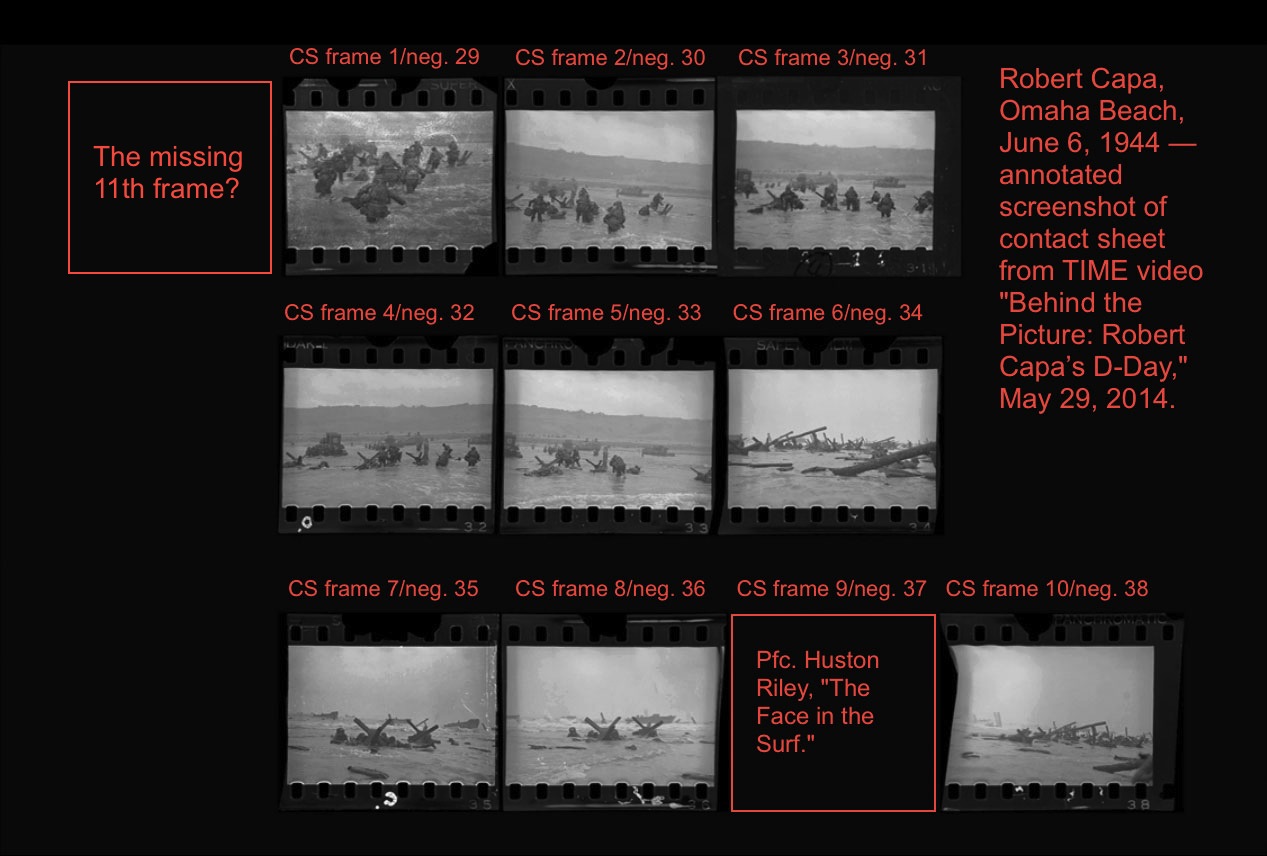
Robert Capa, D-Day images from Omaha Beach, contact sheet, screenshot from TIME video (May 29, 2014), annotated.
So we come back, appropriately, to where all this started — with the convenient fiction created on June 7-8, 1944 by John Morris, and passed along by him with Capa’s eleven (or perhaps ten) D-Day exposures to Wilson Hicks at LIFE‘s head office, who accepted it as true and, feeling obligated to Capa as a result of the presumed destruction of his negatives while in their hands, offered him the staff position he coveted at LIFE. (I’ve yet to access LIFE‘s archives to see if that note resides therein.)
Morris then conveyed both the cover story and the truth to Capa when they met in Normandy in July of that year. Capa had to accept it or blow the whistle on everyone, thereby risking his own reputation and Morris’s and LIFE‘s, not to mention Morris’s job and his own new staff position.
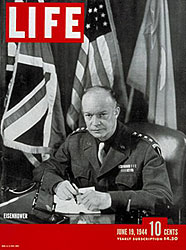
LIFE magazine, June 19, 1944 issue, with Robert Capa’s D-Day images and official U. S. Army Photo of Gen. Eisenhower on cover.
Within a few days of his panic attack on Omaha Beach, Capa began crafting his own version of the cover story, as one can see in the version he offered to LIFE correspondent Charles Wertenbaker. At the time he spoke with Wertenbaker, Capa had apparently not heard from Morris, nor from Hicks in New York; he had no idea what pictures had survived the trip to London, nor which ones Hicks had selected for LIFE‘s D-Day issue, nor how Hicks felt about them. (Nor how Morris felt about getting just 11 negatives of the landing from him.)
The following, attributed to Capa, appears in Wertenbaker’s book Invasion! (New York: D. Appleton-Century Co., 1944), pp. 43-44:
“It was very unpleasant there [on Omaha Beach] and, having nothing else to do, I start shooting pictures. I shoot for an hour and a half and then my film is all used up. I saw an LCI behind me with a lot of medics getting out and some getting killed as they got out. One place being as bad as another, I waded out and waited in the water … Then I climbed aboard and started to change my film. … I took a lot of pictures and then I lay down and told them to wake me in an hour. … When I woke up we were on the way back to England. When we landed I sent my films to London and took the next boat back.”
That summer Capa wrote (by hand) two undated letters home. Both reside in the Capa Archive at the ICP. The first consists of 8 sheets bearing two postmarks stamped on two of its pages: “July 19 1944 New York NY Parcel Post” and “Aug 28 1944 New York NY Parcel Post” — probably censor’s stamps.
Dear Mother and Cornell, this is the first time that I can write since D-Day, I hope Life advised you that I was all right. … I still do not know if my first pictures ever arrived and am rather disturbed. … I also received a cable from Hicks saying that I was the best of the invasion even if most of my pictures were lost and ruined by seawater. I landed the first between the newspapermen from the sea and had a hot time all right. Mother Capas little boy was plenty scared but I seem to be condemned to live 85 years more. … My contract with Hicks is finished in four weeks I wonder what he will offer. … Cornell please write how my pictures were, I do not know what I was taking, what got lost and how are the ones which were printed.
It’s not clear when this was written, nor when Capa mailed it. Presumably it didn’t get delivered until after the censors passed it in late August ’44. Clearly it got sent before Capa saw a copy of the June 19 issue of LIFE, which would almost certainly have made it way to the front by the beginning of July. So I’ll date it tentatively at June 30. At that point, therefore, Capa knew only what Hicks had cabled to him re damage to his negatives by seawater — the official version, as published in LIFE.
The second letter, also handwritten and undated (annotated by an unknown party as July 1944), self-evidently postdates the one excerpted above (Edith was Cornell’s wife):
“Dear Edith and Cornell: … I just got back from London where I had a good time and a bad surprise. I found out that 90% of my invasion material was ruined by drying and the little which got printed is nothing compared to the material which they got ruined.”
I can’t determine exactly when (or even if) Capa went to London during this period. John Morris landed on Utah Beach near Sainte-Mère-Eglise on July 19, and connected with Capa soon thereafter. So either in London shortly before that, or somewhere in Normandy, Capa learned firsthand from Morris of the story he’d invented on the spot to cover Capa’s minimal Omaha Beach output. As far as I can establish, therefore, the dissemination of the myth of emulsion melt in the London darkroom begins here, with this letter, and the first written mention of it comes from Capa himself.
•
By that fall, versions consistent only in the premise of some darkroom disaster started to appear in print. Immediately after his transcription of Capa’s account, above, Wertenbaker added, “Bob Capa had taken 79 pictures of the fighting on the beach. They were the only complete photographic record of the worst hours of the invasion. A careless dark-room assistant ruined all but seven of them.” (P. 44.)
In a chapter on Capa in a book for young people published shortly after Wertenbaker’s, Extra! U.S. War Correspondents in Action (Plainview, NY: Books for Libraries Press, 1945), John McNamara wrote:
“[Capa] had taken nearly a hundred pictures of the desperate fighting on the beaches, most of them during the first terrible hour of the battle, when he was virtually the only photographer on the scene. But only seven of them were ever reproduced. The man in the darkroom in London, by using, in his haste, developing fluids of improper temperature, had ruined all the rest. A darkroom man can often make or break a photographer, and in this case he nearly broke Capa.” (P. 213. McNamara credits Cornell Capa as his source, indicating that Cornell took a lead role in the cover-up early on.)
Since the physical evidence indicates that none of Capa’s D-Day films actually got damaged during or after processing, this story couldn’t have leaked from the darkroom staff of LIFE‘s London office; I’d guess that none of the techs there even knew what story Morris told Wilson Hicks, or Capa, about his Omaha Beach photos — beyond the seawater-damage version that appeared in LIFE, which they’d surely have read. I can’t imagine loyal company man John Morris noising it about, even if he’s the one who made it up; that would make his boss a liar. Nor can I envision the tight-lipped Hicks telling this version to anyone, even if he believed it, as it impeaches his official account of water damage to the film while in transit from Omaha Beach.
Which leaves us with only Capa himself as its likely source. For reasons unexplained, discontented with the official cover story of seawater damage cooked up by Hicks, Capa felt compelled to go public with the emulsion-melt fable. First he rehearsed it anecdotally: to his brother and sister-in-law; to his lover Ingrid Bergman; to Sam Fuller (who heard it from Capa in Hollywood while Capa was working on his memoir, according to the film director’s 2002 autobiography, A Third Face); and to who knows how many others.
Finally Capa put it on the public record in his 1947 book Slightly Out of Focus — the first to do so. From there it spiraled out of control — going viral, becoming a meme, not only infecting Capa’s life story but contaminating the history of photojournalism, the history of photography, and our broader cultural history.
 Major institutions and organizations — TIME, Inc., Magnum Photos, the International Center of Photography — stand implicated in the promulgation of this fiction. A number of prominent functionaries in their administrations — Morris, Cornell Capa, Richard Whelan, Cynthia Young, at the very least — have actively furthered it. Many others have bought into that story, and more than a few have embroidered it. Ultimately, however, responsibility for it rests on the shoulders of John Morris and Robert Capa. And, beyond them, on those who have known better but, cynically, furthered it for their own purposes, thus embarrassing yet others who, trustingly but uncritically, reiterated it along the way.
Major institutions and organizations — TIME, Inc., Magnum Photos, the International Center of Photography — stand implicated in the promulgation of this fiction. A number of prominent functionaries in their administrations — Morris, Cornell Capa, Richard Whelan, Cynthia Young, at the very least — have actively furthered it. Many others have bought into that story, and more than a few have embroidered it. Ultimately, however, responsibility for it rests on the shoulders of John Morris and Robert Capa. And, beyond them, on those who have known better but, cynically, furthered it for their own purposes, thus embarrassing yet others who, trustingly but uncritically, reiterated it along the way.
Ironically, then, Capa’s life and work — committed, above all, to the fight against fascism — has ended up, by his own doing, enmeshed in its very own “big lie,” which, repeated often enough (as that strategy’s progenitor predicted), has become what people believe. An object lesson in how “the big lie” functions. We’ve had 70 years of that lie — enough, surely. It ends here.
•
(For an index of links to all posts in this series, click here.)


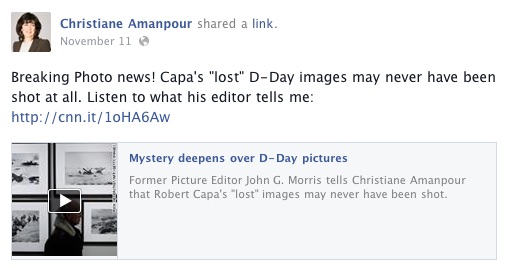
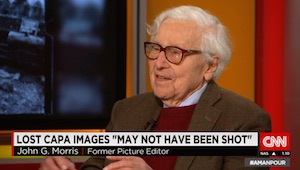
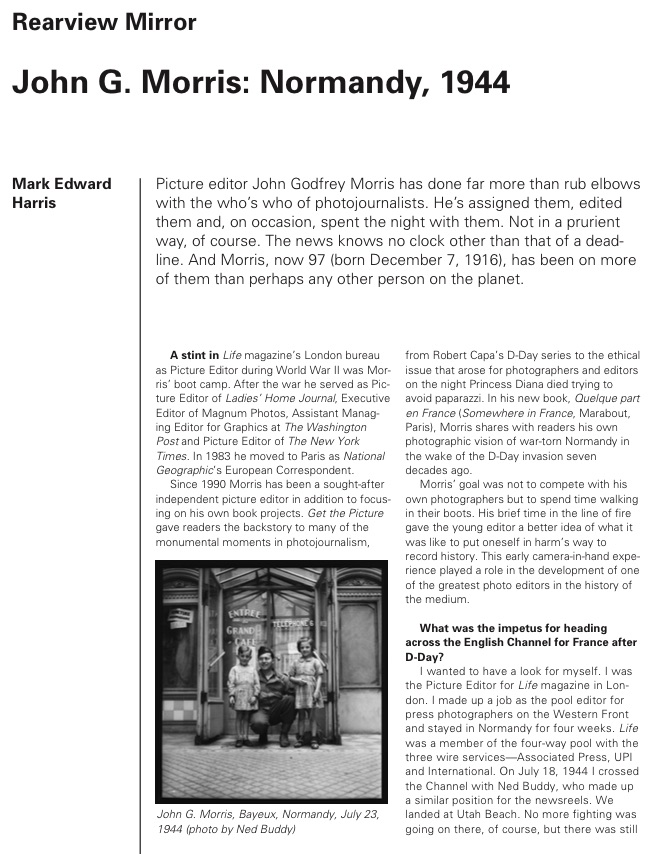
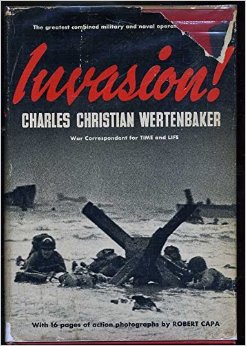
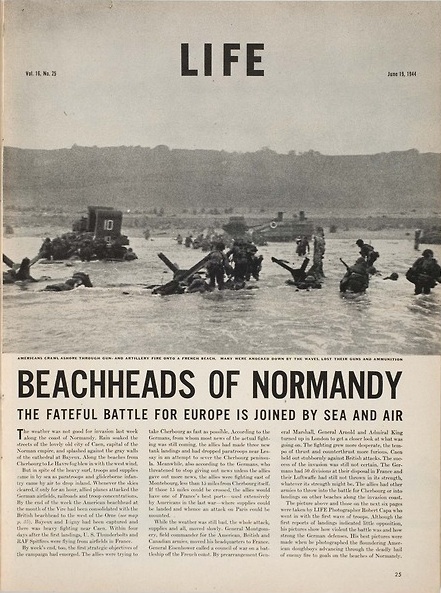
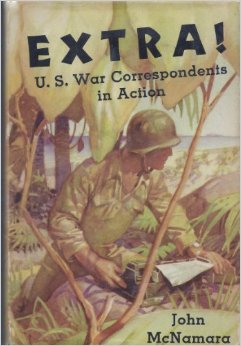
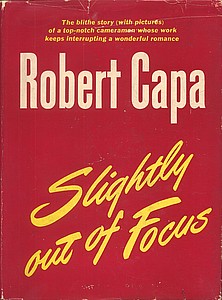




At his blog Re: PHOTO, the U.K.’s Peter Marshall, who has tracked and commented on this investigation from its beginning, just posted a response to the above, “Capa Myth Rumbles On”:
Recommended.
I should add that I no longer believe Capa made eleven exposures on Omaha Beach. We have only Morris’s word for that, and he has proven himself an unreliable witness, to put it kindly. No trace exists of an eleventh exposure. We have ten published pictures. That’s Capa’s total for his brief stay on the beach.
With the forensic evidence now public, the liar now claims credit for discovering the ‘truth’, as if he was an innocent all along. WHO does he think cooked up the excuse in the 1st place? Is Dennis Banks now the sole source of the lie that was innocently believed by the self-proclaimed naive, and technically ignorant, Mr. Morris?
If Capa knew he missed all those shots why would he have sent the spoiled roll to London in the first place? He could have claimed it was lost en route, no? Maybe the shutter malfunctioned and he didn’t know until processing.
Morris may have felt it was his lab’s fault and needed to cover it up, or actually knew it was Capa’s problem and was covering both asses. So now he is trying to un-cover-up his 70 year cover-up and claim both total ignorance and innocence by default. Disingenuous git.
You should contact Christine Amanpour directly. OR … make your own YouTube video expose/documentary and let it compete with all the BS already out there.
XXX, Colleen
I appreciate your indignation over all this. Justified, surely.
I remain skeptical about the existence of Dennis Banks (named as Dennis Sanders in Whelan’s authorized biography). Until I see some documentation — a staff roster, a group photo — I incline to think Morris made him up as well … an imaginary scapegoat for an imaginary disaster.
No defective shutter involved here. Capa handed his film to a courier, headed back to Normandy, and continued to use the same cameras for months.
I have plans for repurposing the accumulated research and analysis in 2015, and disseminating it through other platforms.